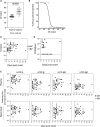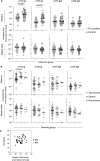Binding antibody titers against the hemagglutinin and neuraminidase correlate with protection against medically attended influenza A and B disease
- PMID: 40358209
- PMCID: PMC12172496
- DOI: 10.1128/jvi.00391-25
Binding antibody titers against the hemagglutinin and neuraminidase correlate with protection against medically attended influenza A and B disease
Abstract
Human challenge and cohort studies have identified various correlates of protection (CoP) against influenza A and B viruses (IAV/IBV). However, associations with viral load, investigation of mucosal CoPs, and CoPs against IBV are limited in the context of natural infections. Plasma and nasal swabs were collected (2017-2020) from 56 adults diagnosed with IAV (n = 25 H1N1, n = 19 H3N2) or IBV (n = 9 B/Victoria, n = 3 B/Yamagata) in the emergency department. Viral load was determined in nasal swabs. Antibodies (total Ig and IgA) specific for the hemagglutinin (HA) and neuraminidase (NA) of contemporary viruses from the subtype or lineage infecting each individual were measured by enzyme-linked immunosorbent assay (ELISA). Antibodies to a non-infecting influenza strain were measured and used as "control cases" to determine associations with protection from infection. Viral load decreased with time post-symptom onset. The Ct value at which 50% of the samples were positive in viral culture was 24.75 (95% confidence intervals, 23.7-27.01). Systemic HA and NA-specific Ig titers correlated with protection from medically-attended influenza disease. Neither systemic nor mucosal antibody measurements were associated with disease severity. We observed an inverse correlation between Ig anti-NA antibodies in nasal swabs and viral load by Ct value (regression coefficient = 3.25, CI = 0.3-6.2, P = 0.031), though this analysis was not corrected for multiple comparisons. Overall, high titers of HA and NA-specific antibodies measured by ELISA were associated with protection from the development of influenza A or B disease. Further work is needed to understand immune parameters associated with viral clearance and mucosal CoPs.IMPORTANCEThere is a great need to better understand correlates of protection (CoP) against influenza A and B viruses (IAV/IBV). In our study, we analyzed paired plasma and nasal swabs from patients presenting with influenza A or B disease as well as control patients. We measured hemagglutinin (HA) and neuraminidase (NA) specific antibodies in both sample types and also determined the amount of virus in nasal swabs. We found that higher systemic binding antibodies to the hemagglutinin and neuraminidase were associated with protection from medically attended disease. These findings expand our understanding of correlates of protection against influenza viruses and identify areas of future research to further understand protection from influenza.
Keywords: antibody; correlates of protection; hemagglutinin; influenza; neuraminidase.
Conflict of interest statement
The Ellebedy laboratory has received funding from Moderna, Emergent BioSolutions, and AbbVie, which is unrelated to the data presented in the current study. A.H.E. has received consulting and speaking fees from InBios International, Inc., Fimbrion Therapeutics, RGAX, Mubadala Investment Company, Moderna, Pfizer, GSK, Danaher, Third Rock Ventures, Goldman Sachs, and Morgan Stanley and is the founder of ImmuneBio Consulting. A.H.E. is the recipient of a licensing agreement with AbbVie unrelated to the data presented in the current study. M.K. has received consulting and speaking fees from the Sanofi group of companies. I.G.B. has shares in an influenza vaccine-producing company. The other authors declare no conflicts of interest.
Figures


Similar articles
-
Headless hemagglutinin-containing influenza viral particles direct immune responses toward more conserved epitopes.J Virol. 2024 Oct 22;98(10):e0116624. doi: 10.1128/jvi.01166-24. Epub 2024 Sep 26. J Virol. 2024. PMID: 39324791 Free PMC article.
-
Influenza vaccine outcomes: a meta-analysis revealing morbidity benefits amid low infection prevention.Eur Respir Rev. 2025 Jan 8;34(175):240144. doi: 10.1183/16000617.0144-2024. Print 2025 Jan. Eur Respir Rev. 2025. PMID: 39778922 Free PMC article.
-
Greater Breadth of Vaccine-Induced Immunity in Females than Males Is Mediated by Increased Antibody Diversity in Germinal Center B Cells.mBio. 2022 Aug 30;13(4):e0183922. doi: 10.1128/mbio.01839-22. Epub 2022 Jul 20. mBio. 2022. PMID: 35856618 Free PMC article.
-
Antigenic Characterization and Pandemic Risk Assessment of North American H1 Influenza A Viruses Circulating in Swine.Microbiol Spectr. 2022 Dec 21;10(6):e0178122. doi: 10.1128/spectrum.01781-22. Epub 2022 Nov 1. Microbiol Spectr. 2022. PMID: 36318009 Free PMC article.
-
The global burden of swine influenza and its mitigation.Open Vet J. 2025 May;15(5):1866-1879. doi: 10.5455/OVJ.2025.v15.i5.3. Epub 2025 May 31. Open Vet J. 2025. PMID: 40557091 Free PMC article. Review.
References
-
- Coudeville L, Bailleux F, Riche B, Megas F, Andre P, Ecochard R. 2010. Relationship between haemagglutination-inhibiting antibody titres and clinical protection against influenza: development and application of a Bayesian random-effects model. BMC Med Res Methodol 10:18. doi: 10.1186/1471-2288-10-18 - DOI - PMC - PubMed
MeSH terms
Substances
Grants and funding
LinkOut - more resources
Full Text Sources
Medical
Miscellaneous

